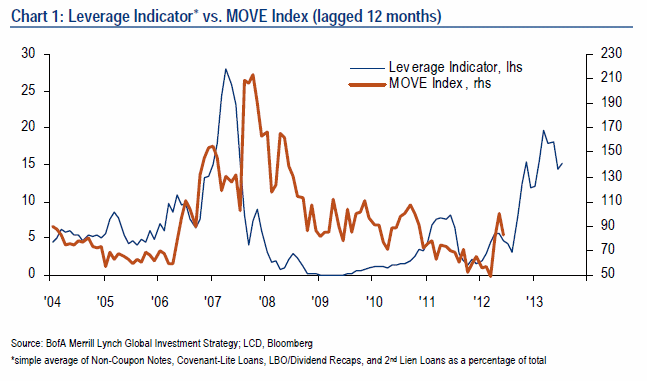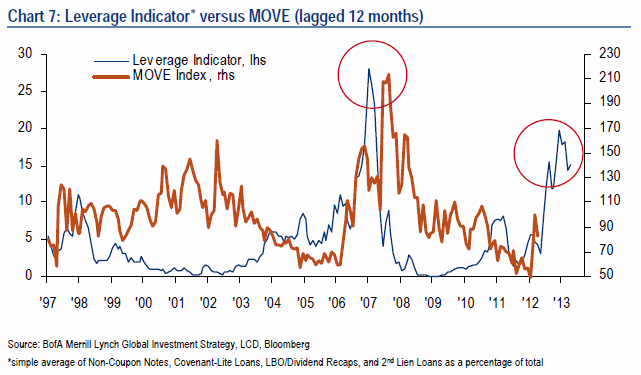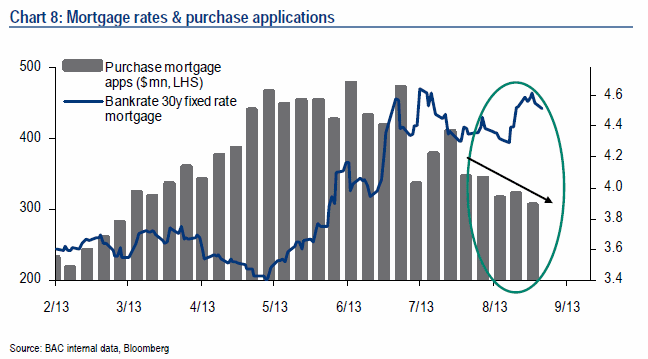When Michael Harnett talks about long term strategy, markets listen. Why? He is Mr. "Great Rotation," the strategy that--In October 2012--predicted that bond yields and stock prices would go way up. That turns out to have been a prescient call, and now he and the global investment strategy research team at Bank of America Merrill Lynch have some concerns about a "crash." That could turn out to merely be an acronym for risks to the outlook or the inherent factors could actually produce a crash for equities. The implication for any sort of reversal of the Great Rotation would be benefit for bond markets.
In an investment letter the team points to leverage indicators they think suggest increased speculation in the market of the sort that preceded the great financial crisis in 2008 and the 9-12 months of excessive volatility in the bond markets.

Hartnett, who coauthored the article with Brian Laung, Global Equity Strategist; John Bilton and Nupur Gupta, European Investment Strategists; and Marish Kabra, Equity Strategist, notes that the equity market is entering the seasonally weak period for risky assets and that U.S. stocks which have not corrected even 10 percent in over two years, may be suddenly facing a "buyers strike." Could this signal the onset of a C.R.A.S.H. for equities and a rally of some degree for bond markets? He suggests investors pay attention to that word, an acronym for Conflict, Rates, Asia, Speculation, and Housing, all potential catalysts for a potentially contagious autumn event.
C is for Conflict
Things had been going pretty well for equities before the situation in Syria escalated. Oil prices are already affected as they were in 2008. The authors note that equities underperform bonds during oil spikes and suggest the benchmark might be the Brent oil price exceeding $125/barrel.
Policy conflicts in emerging markets are also a concern as some try to stem capital outflows and currency loses as rates rise in the U.S
R is for Rates
Bottom line, rates are the punchbowl that's been keeping the global liquidity party going. The Great Rotation calls for this to dry up, but if it dries up too fast, and if it coincides with weaker bank stocks, it could be a sign of a damaged "carry trade" for the world's largest financial institutions where their cost of funding is rising faster than their return on investment.
Another risk is potential mismanagement of the Fed's tapering of quantitative easing which must not carry a hint of too much micro-managing. The impending announcement of a new Fed chairman throws another wild card onto the pile.
A is for Asia
Hartnett notes that Asia and emerging markets are reliving some of their past problems with account deficits. Emerging markets have had a hard time with rising rates and if currency concerns spill over into the Chinese economy, this could pose problems for global growth
S is for Speculation
Hartnett notes that leverage indicators suggest an increased amount of
speculation in the market--the same sort that preceded the 2008 financial
crisis and the 9-12 months of excessive volatility in bond markets.

H is for housing
The recovery in housing which has led to tightening inventories tighten and prices reaching bubble status in some locations appears to have stumbled over rising interest rates. Pending sales as well as construction indicators have been down in recent weeks and mortgage applications are down to levels last seen in 2011. The authors ask if investors, who have been worried about tapering and liquidity, now have to worry about the economy. To be really confident that the recovery overall can be sustained we need to see higher rates and higher growth coexist. The housing market may be hinting at the opposite.

Despite their caution the authors argue that there are several factors that argue against fears of any meltdown in stocks of the magnitude seen in 1987, 1998, and 2008. First, short of a global recession, they do not see stocks as being overvalued at a 13.5 price to forward earnings ratio. Second, they say it is impossible to argue that the markets are significantly overweight in equities and underweight in bonds. The latter market has seen a nearly $1 trillion inflow of funds since 2000 while equities have seen $388 billion in liquidations over the same period. The authors say that while "the structural position in bonds and leverage is a risk skewed towards fixed income, central banks do still control the bond market."

Emerging markets may also be a bright spot for those with a long-term perspective. "An improving long-term risk-reward trade-off could make EM the comeback asset class of 2014," the authors say.







